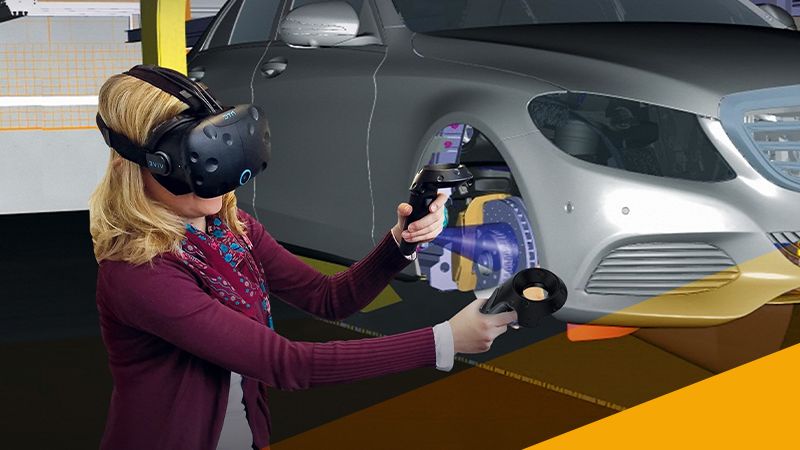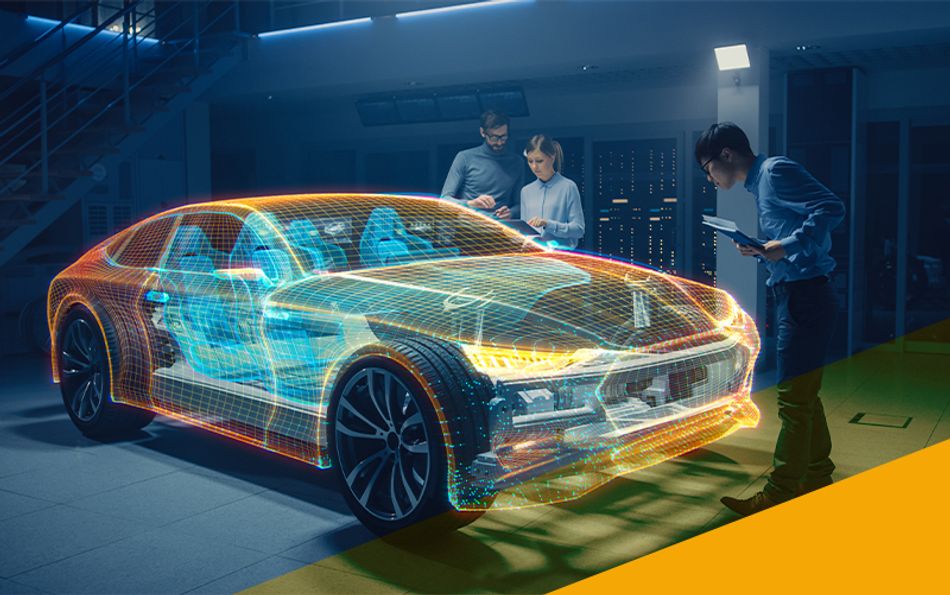How to Drive Faster and More Collaborative Decision-Making for Next-Generation Vehicle Development
Virtual prototyping is essential for efficient, flexible EV development, complementing physical testing to overcome time and cost constraints.
The transportation industry is rapidly evolving, driven by a global shift towards electrification. Ambitious climate goals and growing consumer demand for sustainability have made the electric vehicle (EV) market a center of innovation.
In this evolving landscape, virtual prototyping has become vital for engineers, enabling more efficient and flexible EV development. While physical testing remains essential, its time and cost constraints can limit its effectiveness, making virtual prototyping indispensable for rapid, cost-effective design optimization.
Virtual prototyping leverages predictive, real-time, and immersive simulation software, allowing engineers across domains to design, test, and validate vehicle components and systems in a digital, single-source environment before building any physical prototypes. It accelerates development, reduces costs, and fosters innovation by enabling rapid iteration and collaborative decision-making, particularly in exploring new designs, battery technology, and lightweight materials.
Leading automakers such as Volvo, Toyota, SEAT, Renault, Toyoda Gosei, Hyundai, and Audi have embraced virtual prototyping in some capacity to stay competitive in this ever-evolving EV market and meet growing demands for sustainable, high-performance vehicles. This progressive approach enhances design efficiency and aligns with the industry's broader shift towards innovation.1
ESI Group, a pioneer in this field, has been at the forefront of virtual prototyping since its first-ever crash simulation with Volkswagen in 1985. Today, ESI leads the field by setting new standards for virtual homologation, enabling automakers to validate their designs from the outset and eliminating the need for multiple costly and time-consuming physical prototypes for safety certification.
This article provides an overview of how ESI's virtual prototyping solutions are transforming EV development.
Overcoming Crash and Safety Testing Challenges
Vehicle safety and structural integrity are critical in automotive design, especially for EVs. Simulation techniques are essential for analyzing crash dynamics, safety features, and overall performance. This approach allows designers to rapidly develop innovative solutions that meet evolving regulations and e-mobility challenges, ultimately leading to safer and more efficient vehicles.
Here is how ESI's virtual performance simulation (VPS) software helps engineers tackle the most challenging cases in automotive engineering:
Struggling with tight deadlines for testing crash scenarios? Test various scenarios in virtual crash simulation, including frontal, side pole, and far-side collisions, to evaluate vehicle deformation and its impact on occupants and pedestrians without the cost and delays of physical tests.2
Need to analyze complex airbag deployment? VPS accurately models and simulates airbag folding and deployment, including intricate side curtain airbags and non-uniform pressures, and is renowned for its unmatched accuracy and efficiency.3
Concerned about evaluating battery performance and safety early in development? Assess full car crash scenarios, regulatory crush analysis, and battery stiffness, shock, and swelling in crash and safety simulation to ensure designs meet rigorous safety standards before physical testing.4
Looking for a cost-effective way to assess vehicle strength and dynamics? Use ESI's single simulation tool to evaluate vehicle strength and dynamics, including stiffness, pothole impacts, door and hood durability, and the impact of water crossing. This enhances reliability while reducing testing mileage and material cost, making it more environmentally friendly. 5
In short, ESI's simulation software for virtual crash, safety, and structural testing enables you to effectively manage the complexities of modern vehicle design.
However, another crucial aspect of vehicle performance engineering that demands just as much attention is vibro-acoustic performance.
Mastering Noise and Sound to Enhance EV Acoustics
As vehicle electrification increases, managing acoustic comfort and compliance with noise regulations becomes increasingly crucial. Traditional acoustic testing may not address the complexities of new EVs, making virtual vibro-acoustic simulation a more comprehensive approach for optimizing interior and exterior noise.
But how efficiently can you conduct vibro-acoustic analysis? Are you struggling to ensure a quiet, comfortable environment for passengers while meeting pass-by noise regulations and ensuring effective acoustic warning systems?
Here's how ESI's vibro-acoustic simulation software can help you test and optimize interior and exterior noise performance, ensuring comfort, compliance and protection:
Airborne Noise Simulation: Optimizes how noise control treatments affect cabin acoustics.
Structure-Borne Noise Analysis: Evaluates noise generated through structural loads.
Sound Package Design and Optimization: Designs and tests noise control countermeasures to enhance acoustic performance.
Pass-By Noise (PBN) Simulation: Ensures vehicles meet regulatory noise standards.
Acoustic Vehicle Alerting Systems (AVAS): Designs effective warning sounds to enhance safety.
Wind Noise: Predicts the effect of wind noise on acoustic comfort by integrating CFD data into the vehicle models.
Auralization: Creates realistic sound scenarios to evaluate the acoustic environment before physical testing.
Road Noise Simulation: Predicts and optimizes noise levels from road interactions.6,7
With safety and acoustic performance validated, the next step is manufacturability. Just as simulation software has transformed performance testing, manufacturing simulation enhances and optimizes production processes and part performance, ensuring the designs are realized with precision and efficiency.
Virtual Manufacturing for Lightweight Materials and Processes
Lightweight materials are essential in modern vehicle body and chassis design as automakers seek to reduce weight for improved fuel efficiency and performance. This shift has led to a transition from only steel to multi-material strategies that combine steel with aluminum and composites such as carbon fiber.
While these approaches reduce vehicle weight and maintain excellent crash performance, they also introduce new manufacturing challenges, necessitating the validation of the optimal combination of lightweight materials and joining processes to achieve the best performance-cost-weight ratio.
To address these challenges, automakers should frontload their manufacturing decisions by creating a virtual manufacturing process chain. This approach provides early confidence in material selection, manufacturing methods, and assembly processes before physical production, reducing the risk of costly revisions and ensuring a smoother transition from design to manufacturing.
ESI's multi-material assembly simulation allows for thorough evaluation and optimization using the following virtual manufacturing simulation tools:
ProCAST: Predicts and eliminates defects, such as misruns, inclusions, shrinkage porosity, cracks, and excessive distortions, in various casting processes, including large-scale or mega castings.8
PAM-STAMP: Virtually assesses defect formation, predicts and compensates for spring back in high-strength steels and aluminum, and explores advanced processes like press hardening.9
SYSWELD: Ensures robust, durable spot welds by predicting weld strength and quality. Analyze each assembly step, minimize distortions from gap closing and joining processes, and optimize weld sequences to control final assembly distortions. 10
PAM-COMPOSITES: The only complete simulation chain that identifies and fixes manufacturing defects in composite products, covering draping, thermoforming, various resin molding processes, infusion, curing, and geometrical distortions.11
However, developing sustainable, safe, and comfortable vehicles is just one part of the equation; integrating the human aspect from the early design stages is crucial for perfecting a new vehicle.
This is where advanced immersive virtual reality (VR) software comes into play.
The Industrial Metaverse for Virtual Build and Immersive Product Integration
Innovating in EV design and manufacturing introduces new risks that may not be apparent until production begins. These include components integration, assembly, installation or removal challenges, and maintenance issues.
Without physical prototypes for early evaluation, these issues can lead to production bottlenecks and missed opportunities for optimization, impacting EV's overall success.
ESI's IC.IDO (virtual reality software) offers an innovative solution, allowing automakers to experience their products within a collaborative industrial metaverse. It provides physically realistic virtual experiences for product assembly and maintenance, offering opportunities to:
Evaluate space constraints, clearances, visibility, and component accessibility.
Assess and optimize cable and hose routing and handling.
Define and refine installation and removal paths.
Develop, test, playback, refine, and optimize assembly processes.
Validate procedures, work cells, and production lines.
Identifying potential issues early with VR accelerates the development process, reduces costs, and improves the quality and safety of the final product. Therefore, automakers can optimize the entire product lifecycle from initial concept to final assembly by simulating real-world interactions with virtual prototypes.
Discover More EV Innovation at ESI LIVE Automotive
To explore these fundamental simulation technologies in detail and gain valuable insights from leading experts, attend ESI LIVE Automotive. This event offers a comprehensive overview of predictive modeling and virtual prototyping through practical examples from the automotive industry.
Attendees will learn about optimizing EV safety and comfort, mastering noise and sound, virtual manufacturing for lightweight materials, and the role of the industrial metaverse in virtual build and product integration.
Discover how these technologies are advancing electric vehicle design. Join us to gain valuable insights from industry experts and stay up-to-date with the latest developments.
What: ESI Live automotive digital event
When: October 24th, 2-4 PM CET
Register: Free to attend.
For more information and to register, visit ESI LIVE Automotive.
References
ESI Group. How is Virtual Prototyping Accelerating Electric Vehicle Development? [Online]. Available at: https://www.esi-group.com/ebook-how-is-virtual-prototyping-accelerating-electric-vehicle-development
ESI Group. Virtual Performance Solution - Software to Simulate & Test Crash & Safety. [Online]. Available at: https://www.esi-group.com/products/virtual-performance-solution/crash-and-safety
Baccari, N. Toyoda Gosei Europe Cuts Lead Times in Half Using Virtual Prototyping. (2020). [Online]. Available at: https://www.esi-group.com/blog/toyoda-gosei-europe-cuts-lead-times-in-half-using-virtual-prototyping
ESI Group. Software to Simulate Battery Safety. [Online]. Available at: https://www.esi-group.com/products/virtual-performance-solution/battery-safety
ESI Group. Software to Simulate Strength & Dynamics. [Online]. Available at: https://www.esi-group.com/products/virtual-performance-solution/strength-and-dynamics
ESI Group. Simulation Software Solutions for Acoustic Performance. [Online]. Available at: https://www.esi-group.com/industries/automotive/simulation-software-solutions-for-acoustic-performance
ESI Group. VA One - Interior Acoustics Simulation Software. [Online]. Available at: https://www.esi-group.com/products/va-one/interior-acoustics-simulation-software
ESI Group. ProCAST - Casting Simulation Software. [Online]. Available at: https://www.esi-group.com/products/procast
ESI Group. PAM-COMPOSITES - Composite Simulation Software. [Online]. Available at: https://www.esi-group.com/products/pam-composites
ESI Group. SYSWELD - Welding & Assembly Simulation Software. [Online]. Available at: https://www.esi-group.com/products/sysweld
ESI Group. PAM-STAMP - Stamping Simulation Software. [Online]. Available at: https://www.esi-group.com/products/pam-stamp
ESI Group. IC.IDO - Virtual Reality Engineering Software. [Online]. Available at: https://www.esi-group.com/products/ic-ido


